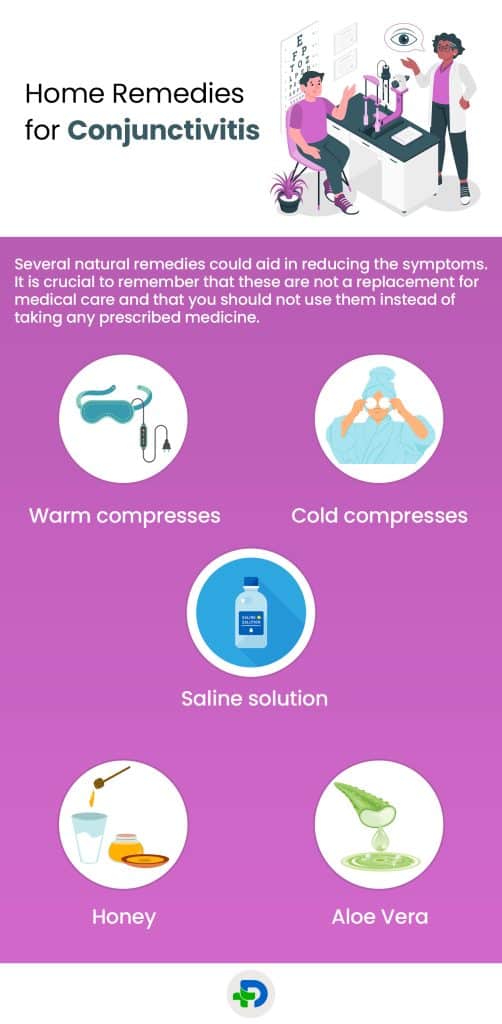Conjunctivitis: Types, Symptoms, and Management

- Conjunctivitis
- 14 Aug 2023
Overview
What is conjunctivitis ?
When the conjunctiva, a thin, transparent layer of tissue that lines the inside of the eyelid and covers the white part of the eye, becomes inflamed or infected, it is known as conjunctivitis, which is also referred to as pink eye. 1What is conjuctivitis| Researched based study from Nlm.nih.gov
Viral or bacterial infection and an allergic response to irritants like pollen, dust, or animal dander can contribute to this condition. It is most frequently discovered in children and can spread quickly.

Causes
What are the causes?
There are many potential causes of pink eye, including:
Viruses
- The viruses that cause the flu or the common cold can also cause this, which is the most frequent reason.2Causes| Researched based study from Cdc.gov
Bacteria
- Infections with bacteria can also result in pink eye. Staphylococcus aureus and Streptococcus pneumoniae are common bacteria types.2Causes| Researched based study from Cdc.gov
Allergens
- Allergies to substances like dust mites, pollen, and cat dander.
Irritants
- Exposure to irritants like smog, smoke, or chemicals.2Causes| Researched based study from Cdc.gov
Wearing contact lenses
- Not cleaning the contact lenses correctly or wearing them for long periods.2Causes| Researched based study from Cdc.gov
New-born
- Birth-related infection.
Autoimmune conditions
- Inflammatory conditions like lupus or rheumatoid arthritis may occasionally bring it on. 2Causes| Researched based study from Cdc.gov
Types
Types of Conjunctivitis
Viral conjunctivitis
- This is the most prevalent kind and is brought on by viruses like adenovirus. It spreads rapidly and easily from person to person and is highly contagious.2Types| Researched based study from Cdc.gov
- It may also happen if you have a cold and blow your nose too forcefully. Your respiratory system pushes the virus to your eyes.
- Viruses like the enterovirus, varicella-zoster virus, and herpes simplex virus can also bring it on.
Bacterial conjunctivitis
- It is a highly contagious bacterial infection that is easily spread by contacting an infected person or contaminated items.2Types| Researched based study from Cdc.gov
Allergic conjunctivitis
- Caused by an allergic response to dust, pollen, or pet dander. This kind usually affects both eyes and is not contagious.2Types| Researched based study from Cdc.gov
Chemical conjunctivitis
- Caused by contact with allergens like smoke, air pollution, or pool chlorine.2Types| Researched based study from Cdc.gov
Conjunctivitis in new-born.
- Usually occurs within the first ten days of life in new born infants. A virus or bacteria might bring it on the woman contracted while giving birth. 2Types| Researched based study from Cdc.gov
Symptoms
How do I know if I have a pink eye?
Depending on what caused the inflammation, different symptoms may be present. However, a few widespread signs include:
- Color: Eye whites may look pink or red when they are red.
- Swelling: The cornea may swell, giving the eyes a puffy appearance.
- Discharge: Depending on the pink eye type, there may be an ocular discharge. It can be thin, watery, yellow, green, or vicious. 1Symptoms| Researched based study from Nlm.nih.gov
- Itching: The eyes might itch, and you might feel compelled to massage them.
- A searing or stinging sensation may be experienced in the eyes.
- Light sensitivity: The eyes may be light-sensitive, making bright interior and outdoor environments uncomfortable. 1Symptoms| Researched based study from Nlm.nih.gov
- Vision blur: In some circumstances, it may result in fuzzy or blurry vision.1Symptoms| Researched based study from Nlm.nih.gov
Diagnosis
Diagnosis of conjunctivitis
Medical evaluation
- A physical examination of the eyes, an analysis of the patient’s symptoms, and a review of their medical background are usually required for the diagnosis.
- The doctor might inquire about a recent interaction with someone with an eye infection or recent exposure to allergens like pollen or pet dander.1Diagnosis| Researched based study from Nlm.nih.gov
Lab tests
- The doctor may occasionally take a sample of the discharge from the eye and send it to a lab for analysis to identify the reason. A swab or a tiny discharge piece may be used for this.1Diagnosis| Researched based study from Nlm.nih.gov
Staining
- Fluorescein is a specialised dye that the doctor may use to look for any abrasions or alien objects on the eye’s surface.
- In this method, a tiny quantity of the dye is applied to an affected eye, and any areas stained by the dye are then visible under blue light. 1Diagnosis| Researched based study from Nlm.nih.gov
Additional tests
- Additional tests may be requested to confirm the diagnosis if the doctor thinks the pink eye is brought on by an underlying medical condition, such as an autoimmune disorder or a sexually transmitted infection.
- The patient’s symptoms and the outcomes of a physical examination are usually combined to form the basis of the diagnosis. 3Diagnosis| Researched based study from Nlm.nih.gov
Treatment
How is conjunctivitis treated?
Viral conjunctivitis
- Antihistamines, eye drops, and cold compresses are commonly used to treat symptoms. Antibiotics are rarely recommended because they are ineffective against viral infections. 4Treatment| Researched based study from Cdc.gov
- Most of the time, it will go away on its own in a week or two, though in some instances, the symptoms may last for several weeks.
Bacterial conjunctivitis
- Eye drops or ointments are used as treatment. Symptoms typically improve a few days after beginning treatment, and the medication is generally prescribed for 5-7 days.4Treatment| Researched based study from Cdc.gov
- Warm compresses can also ease discomfort and aid with symptom relief.
An allergic conjunctivitis
- Using oral medications, prescribed antihistamine eye drops, or over-the-counter drugs like Benadryl.
- A doctor may prescribe corticosteroid eye drops in severe instances to reduce inflammation. These medications are typically only used for brief periods because prolonged use has side effects. 4Treatment| Researched based study from Cdc.gov
Remedies

Home remedies for conjunctivitis
Several natural remedies could aid in reducing the symptoms. It is crucial to remember that these are not a replacement for medical care and that you should not use them instead of taking any prescribed medicine.
Warm compresses
- Warm compresses can soothe inflammation and lessen redness in the afflicted eye.
- Warm water should be used to soak and rinse out a clean washcloth. Place the poultice over the closed eye several times a day for 5 to 10 minutes. 4Home remedies| Researched based study from Cdc.gov
Cold compresses
- This might reduce puffiness and itching. Position the affected eye over a few ice cubes wrapped in a fresh towel for a few minutes. 4Home remedies| Researched based study from Cdc.gov
Saline solution
- Saline solution eye rinses can help to clear out secretion and lessen swelling.
- Combine one teaspoon of salt with 1 cup of warm water to create a saline solution. Apply a few droplets to the afflicted eye using an eyedropper.4Home remedies| Researched based study from Cdc.gov
Honey
- Applying raw honey may help combat infection and reduce inflammation.
- Honey can irritate the skin, so it should be used with care. Before using, dilute the honey with an equal quantity of water.
Aloe Vera
- Aloe Vera lotion application could relieve discomfort. Apply the gel to the troublesome region with a fresh cotton swab.4Home remedies| Researched based study from Cdc.gov
Prevention
How do I prevent myself from getting a pink eye?
Here are some basic recommendations to stop the pink eye from spreading:
Maintain proper sanitation.
- Use soap and water to frequently wash your hands, particularly after touching your face or eyes. 5Prevention| Researched based study from Nlm.nih.gov
Avoid touching your eyes.
- Doing so can transfer bacteria and viruses to your eyes, refrain from rubbing your eyes, applying eye make-up or touching your face.5Prevention| Researched based study from Nlm.nih.gov
Use separate towels
- Towels should be kept separate for each member of the family.
Do not exchange personal items.
- Never give others access to intimate items like eye drops, contacts, or eye makeup.5Prevention| Researched based study from Nlm.nih.gov
Keep everything tidy
- To stop the spread, frequently clean areas like doorknobs and countertops. Wash your hands before applying eye drops.
Wear safety glasses.
- When swimming, gardening, or engaging in other activities that could subject your eyes to irritants or infection, don safety goggles.5Prevention| Researched based study from Nlm.nih.gov
Treat underlying conditions
- Medical problems like allergies or autoimmune diseases should be treated to avoid recurrent pink eye.
Avoid public places
- If you are diagnosed with pink eye, try avoiding public places like school, markets, office and crowded areas to limit the spread.5Prevention| Researched based study from Nlm.nih.gov
Complications
What are the Complications ?
Corneal ulcers
- In severe instances, corneal ulcers can develop due to an infection that spreads to the cornea, the eye’s transparent outer layer. If left untreated, it can result in discomfort, redness, light sensitivity, and vision loss. 5Complications| Researched based study from Nhsinform.scot
Lack of vision
- Pink eye can cause vision loss if it is not addressed right away. This is particularly valid when the watch is infected. 5Complications| Researched based study from Nhsinform.scot
Keratitis
- This corneal inflammation may result in discomfort, redness, and vision issues.
Pre-septal cellulitis
- It affects the eyelid and surrounding region and is caused by bacteria. If the infection spreads, it might happen. 5Complications| Researched based study from Nhsinform.scot
Orbital cellulitis
- A severe disease called conjunctivitis results when the infection spreads to the tissue surrounding the eye. If not handled immediately, it can be fatal and cause fever, excruciating pain, and vision loss. 5Complications| Researched based study from Nhsinform.scot
Recurring infections
- Recurring episodes can be a symptom of an underlying illness or a weakened immune system in some individuals. 5Complications| Researched based study from Nhsinform.scot
Emergency
When should I dial the doctor’s number?
Immediately call the healthcare professional if one’s having any of the following symptoms :
- Severe ocular discomfort or light sensitivity
- Eyesight alterations or blurry vision, ocular redness
- Extremely severe swelling.
- A compromised immune system is brought on by conditions like HIV/AIDS, cancer therapy, or other illnesses.
- Injury to the eyes or recent eye surgery
- Symptoms that are persistent or do not improve after treatment.
Takeaway
Key Takeaways
- Conjunctivitis is highly contagious, not a severe condition, and the complications can be very well prevented with early diagnosis and care.
- Good hygiene is a crucial factor in the treatment.
- Preventing the spread of disease is highly important for the benefit of family, friends and society.
Any feedback on this article?
 This Articles content was accurate
This Articles content was accurate Very Informative Article
Very Informative Article I have a question or a comment
I have a question or a comment
 This article contains inaccurate content
This article contains inaccurate content This article was not helpful
This article was not helpful I have a question or a comment
I have a question or a comment
We appreciate your helpful feedback!
Checkout our social pages
References
-
National Library of Medicine
Conjunctivitis: Overview | Introduction | Symptoms
-
Centers for Disease Control and Prevention
Conjunctivitis (Pink Eye) | Types | Causes
-
National Library of Medicine
Conjunctivitis: Diagnosis and Management | Diagnosis
-
Centers for Disease Control and Prevention
Conjunctivitis | Treatment
-
National Library of Medicine
Weep, oh mine eyes: an outbreak of bacterial conjunctivitis | Prevention
-
NHS inform
Conjunctivitis | Complications



































